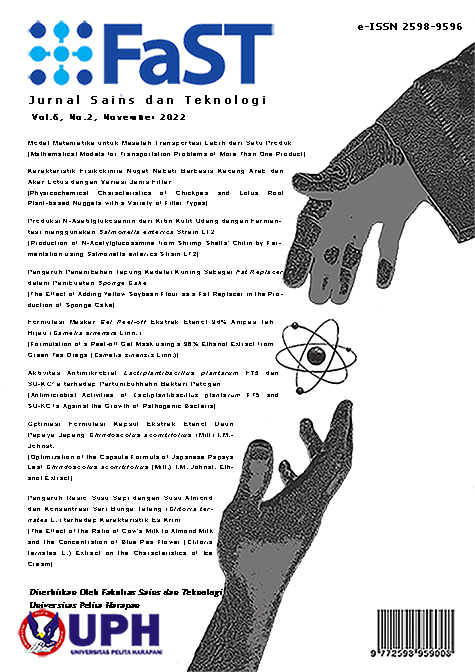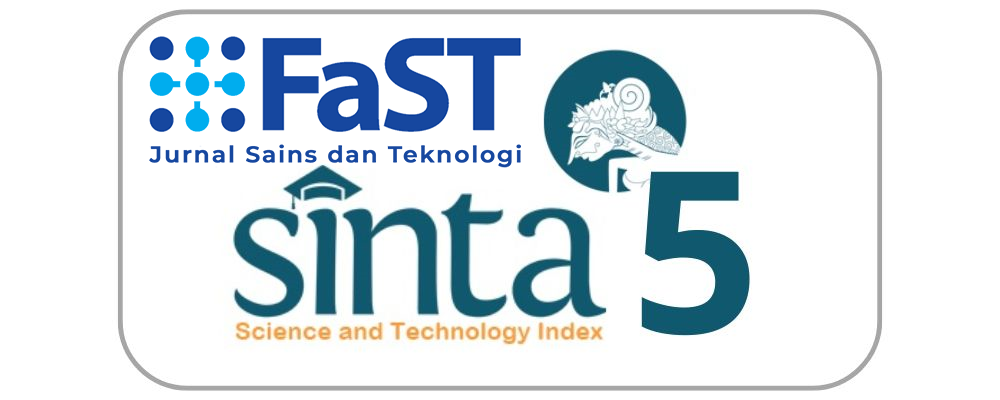FORMULASI MASKER GEL PEEL-OFF EKSTRAK ETANOL 96% AMPAS TEH HIJAU (Camellia sinensis Linn.) [FORMULATION OF A PEEL-OFF GEL MASK USING A 96% ETHANOL EXTRACT FROM GREEN TEA DREGS (Camellia sinensis Linn.)]
DOI:
https://doi.org/10.19166/jstfast.v6i2.6080Keywords:
Camellia sinensis Linn, green tea dregs, hydroxy propyl methyl cellulose, peel-off gel mask, polyvinyl alcoholAbstract
Green tea (Camellia sinensis Linn.) is widely consumed in Indonesia, but the dregs which are waste have not been utilized optimally. A previous study revealed that a 96% ethanol extract from green tea dregs produces antibacterial activity against Staphylococcus aureus and Escherichia coli. Therefore, the purpose of this study was to increase the utilization of green tea dregs in cosmetic products in the form of a peel-off gel mask with an active ingredient of 96% ethanol extract from green tea dregs. The green tea dregs extract was made by the maceration method with 96% ethanol as the solvent. The peel-off gel mask was made in three formulas with different variations in the gel base, namely PVA 10% and HPMC 2%; PVA 8% and HPMC 3%; PVA 5% and HPMC 4%. The peel-off gel mask was produced, then it was evaluated by an organoleptic test, pH test, homogeneity test, spreadability test, and dry time test. The peel-off gel was stored for 10 days at two different temperatures, namely room temperature, and refrigerator temperature. The evaluation result was obtained that all three formulations of the peel-off gel mask met the criteria for good gel. However, after 10 days of storage at both storage temperatures, there was a change in the color of the three formulas. The Formula 3 (PVA 5% and HPMC 4%) stored at refrigerator temperature also showed an increment in dry time result. These results indicate the instability of the peel-off gel mask during storage. The peel-off gel mask formula from green tea dregs meets the requirements of gel preparations.
Bahasa Indonesia Abstract:
Teh hijau (Camellia sinensis Linn.) banyak dikonsumsi di Indonesia, namun ampas yang merupakan limbahnya belum dimanfaatkan secara optimal. Pada penelitian sebelumnya ekstrak etanol 96% ampas teh hijau memiliki aktivitas antibakteri pada Staphylococcus aureus and Escherichia coli. Oleh karena itu, tujuan dari penelitian ini adalah untuk meningkatkan pemanfaatan ampas teh hijau menjadi produk kosmetika berupa masker gel peel-off dengan bahan aktif ekstrak etanol 96% ampas teh hijau. Ekstrak ampas teh hijau dibuat dengan metode maserasi dengan pelarut etanol 96%. Masker gel peel-off dibuat dalam tiga formula dengan variasi basis gel yang berbeda, yaitu PVA 10% dan HPMC 2%; PVA 8% dan HPMC 3%; PVA 5% dan HPMC 4%. Masker gel peel off yang dihasilkan kemudian dievaluasi dengan uji organoleptik, uji pH, uji homogenitas, uji daya sebar, dan uji waktu kering. Gel peel off disimpan selama 10 hari pada dua suhu yang berbeda yaitu suhu ruang dan suhu lemari es. Hasil evaluasi diperoleh bahwa ketiga formulasi masker gel peel-off memenuhi kriteria sediaan gel yang baik. Namun setelah 10 hari penyimpanan pada kedua suhu penyimpanan, terjadi perubahan warna pada ketiga formula. Formula 3 (PVA 5% dan HPMC 4%) yang disimpan pada suhu lemari es juga menunjukkan peningkatan hasil waktu kering. Hasil ini menunjukkan ketidakstabilan sediaan selama penyimpanan.
References
Allen, L. V. (2012). The art, science, and technology of pharmaceutical compounding (5th ed.). American Pharmacist Association.
Anwar, E. (2012). Eksipien dalam Sediaan Farmasi. Dian Rakyat.
Ariani, L. W., & Wigati, D. (2014). Formulasi masker gel peel off ekstrak etanol kulit buah jeruk manis (Citrus sinensis) sebagai obat jerawat. Media Farmasi Indonesia, 11(2), 1084-1092.
Barnard, C. (2011). Investigating the effect of various film-forming polymers on the evaporation rate of a volatile component in a cosmetic formulation (Doctoral Dissertation). Nelson Mandela Metropolitan University, South Africa.
Bayan, P., & Purwanti, L. (2019). Perbandingan aktivitas antioksidan dari ekstrak etanol ampas teh hitam dan teh hijau (Camellia sinensis (L.) Kuntze) dengan metode DPPH serta penentuan kadar polifenol. Prosiding Farmasi, 5(2), 321-328.
Birck, C., Degoutin, S., Tabary, N., Miri, V., & Bacquet, M. (2014). New crosslinked cast films based on poly (vinyl alcohol): preparation and physico-chemical properties. Express Polymer Letters, 8(12), 941-952. http://dx.doi.org/10.3144/expresspolymlett.2014.95
Dhillon, K. S., & Varshney, K. R. (2013). Study of microbiological spectrum in acne vulgaris: an in vitro study. Scholars Journal of Applied Medical Sciences, 1(6), 724-727.
Djajadisastra, J. (2004). Cosmetic Stability. Seminar Setengah Hari HIKI. Departemen Farmasi Fakultas Matematika dan Ilmu Pengetahuan Alam Universitas Indonesia.
Fauzia, S. F., & Djajadisastra, J. (2014). Uji aktivitas antioksidan dan kestabilan fisik sediaan krim ekstrak daun teh hijau dan krim ekstrak daun teh putih (Camellia sinensis. L) (Doctoral Dissertation). Universitas Indonesia, Jakarta, Indonesia.
Garg, A., Aggarwal, D., Garg, S., & Sigla, A. K. (2002). Spreading of semisolid formulation: An update. Pharmaceutical Technology, 26(9), 84-105.
Herwin, Sari, Z. P., & Nuryanti, S. (2018). Aktivitas antibakteri eksktrak etanol daun dan ampas teh hijau (Camellia sinensis Linn.) terhadap bakteri penyebab jerawat (Propionibacterium acne dan Staphylococcus epidermis) secara difusi agar. As-Syifaa Jurnal Farmasi, 10(2), 2085-4714.
Himawan, R. (2008). Pengaruh pemberian ekstrak daun teh hijau terhadap kadar SGPT tikus putih yang diinduksi isoniazid (Undergraduate Thesis). Universitas Sebelas Maret, Surakarta, Indonesia.
Izzati, M. K. (2014). Formulasi dan uji aktivitas antioksidan sediaan masker peel off ekstrak etanol 50% kulit buah manggis (Garcinia mangostana L.) (Undergraduate Thesis). Fakultas Kedokteran dan Ilmu Kesehatan, Universitas Islam Negeri Syarif Hidayatullah Jakarta, Indonesia.
Karmilah, & Musdalipah. (2018). Formulasi krim antijerawat ekstrak ampas teh hijau (Camellia sinensis L). Jurnal Insan Farmasi Indonesia, 1(1), 26-33.
Katsambas, A., & Dessinioti C. (2008). New and emerging treatments in dermatology: Acne. Dermatologic Therapy, 21(2), 86-95.
Kementrian Kesehatan Republik Indonesia. (2020). Farmakope Indonesia: Edisi VI. Kementrian Kesehatan Republik Indonesia.
Kushiyama, M., Shimazaki, Y., Murakami, M., & Yamashita, Y., (2009). Relationship between intake of green tea and periodontal disease. Journal Periodontal, 80(1), 372-377. https://doi.org/10.1902/jop.2009.080510
Lachman, L., Lieberman, H. A., & Kanig, J. L. (1994). Teori dan Praktek Farmasi Industri (3rd ed.). Universitas Indonesia Press.
Murphy, L. J. (1978). Moisturization a Systematic Approach in Moisturizing and Emollient. Documentary Part I. C. J. Patterson Company.
Pertiwi, P. L. (2012). Formulasi masker gel masker peel off ekstrak bongkahan gambir (Uncaria gambir Roxb.) dengan basis kitosan dan polivinil alkohol (PVA) (Undergraduate Thesis). Fakultas Kedokteran dan Ilmu Kesehatan, UIN Syarif Hidayatullah, Jakarta, Indonesia.
Rahmawanty D., Yulianti N., & Fitriana M. (2015). Formulasi dan Evaluasi Masker Wajah Peel-Off Mengandung Kuersetin dengan Variasi Konsentrasi Gelatin dan Gliserin. Media Farmasi, 12(1), 17-32.
Rowe, R. C., Paul, J. S., & Marian, E. Q. (2009). Handbook of Pharmaceutical Excipients (6th ed.). Pharmaceutical Press.
Savira, F., & Suharsono, Y. (2013). Aktivitas antibakteri ekstrak etanol daun dan ampas teh hijau (Camellia sinensis L.) terhadap bakteri penyebab jerawat (Propionibacterium acne dan Staphylococcus epidermidis) secara difusi agar. Journal of Chemical Information and Modeling, 01(01), 1689-1699.
Saqifah, N., Purbowati, E., & Rianto, E. (2010). Pengaruh ampas teh dalam pakan konsentrat terhadap konsentrasi VFA dan NH cairan rumen untuk mendukung pertumbuhan sapi peranakan Ongole. Proceeding Seminar Nasional Peternakan dan Veteriner. Balai Penelitian Ternak.
Septiani, S., Wathoni, N., & Mita, S. R. (2011). Formulasi sediaan masker gel antioksidan dan ekstrak etanol biji melinjo (Gnetum Gnemon Linn.). Fakultas Farmasi Universitas Padjajaran, Bandung, Indonesia.
Siepmaan, F., Hoffmann, A., Leclercq, B., Carlin, B., & Siepmann, J. (2007). How to adjust desired drug release patterns from ethylcellulose-coated dosage forms. Journal of Controlled Release, 119, 182-189. https://doi.org/10.1016/j.jconrel.2007.02.003
Slavtcheff, C. S. (2000). Komposisi kosmetik untuk masker kulit muka. Indonesia Patent 2000/0004913.
Tong, S. Y. C., Davis, J. S., Eichenberger, E., Holland, T. L., & Fowler, V. G. (2015). Staphylococcus aureus infections: Epidemiology, pathophysiology, clinical manifestations, and management. Clinical Microbiology Reviews, 28(3), 603-661. https://doi.org/10.1128/cmr.00134-14
Tranggono, R. I., Fatma, L., & Jayadisastra. (2007). Buku Pegangan Ilmu Kosmetik. Gramedia Pustaka Utama.
Trisina, J., Riskianto, Santoso, F. R. C., & Nainggolan S. B. R. (2021). Skrining fitokimia dan antibakteri ekstrak etanol 96% ampas teh hijau (Camellia sinensis Linn.) terhadap bakteri Staphylococcus aureus & Escherichia coli. Proceeding Seri Seminar Nasional Universitas Tarumanagara II. 1454-1466.
Vieira, R. P., Fernandes, A. R., Kaneko, T. M., Consiglieri, V. O., Oliveira Pinto, C. A. S., Pereira, C. S. C., Baby, A. R., & Velasco, M. V. R. (2009). Physical and physicochemical stability evaluation of cosmetic formulations containing soybean extract fermented by Bifidobacterium animalis. Brazilian Journal of Pharmaceutical Science, 45(3), 515-525.
Voight, R. (1994). Buku Pelajaran Teknologi Farmasi (terjemahan Soendami Noerono) (5th ed.). Gajah Mada University Press.
Widyaningrum, N. (2017). Development of anti acne cream (w/o/w multiple emulsion) containing green tea leaf waste. Sains Medika, 8(2), 74-78.
Widyaningrum, N., Badie’ah, B., & Lestari, S. (2017). Antibacterial activity of the dregs of green tea leaves (Camellia sinensis L.) on Staphylococcus epidermidis as causes of acne. Journal of Science & Science Education, 1(2), 1-5. https://doi.org/10.24246/josse.v1i2p1-5
Downloads
Published
Issue
Section
License
“Authors who publish with this journal agree to the following terms:
1) Authors retain copyright and grant the journal right of first publication with the work simultaneously licensed under a Creative Commons Attribution License (CC-BY-SA 4.0) that allows others to share the work with an acknowledgement of the work's authorship and initial publication in this journal.
2) Authors are able to enter into separate, additional contractual arrangements for the non-exclusive distribution of the journal's published version of the work (e.g., post it to an institutional repository or publish it in a book), with an acknowledgement of its initial publication in this journal.
3) Authors are permitted and encouraged to post their work online (e.g., in institutional repositories or on their website). The final published PDF should be used and bibliographic details that credit the publication in this journal should be included.”



